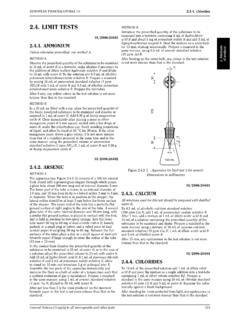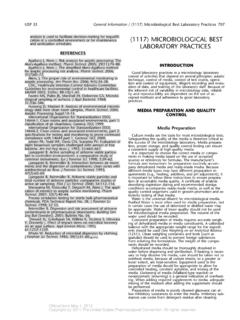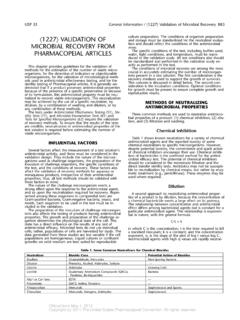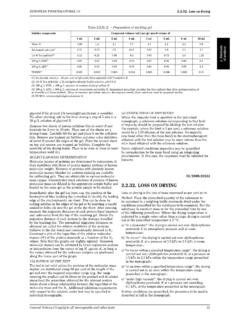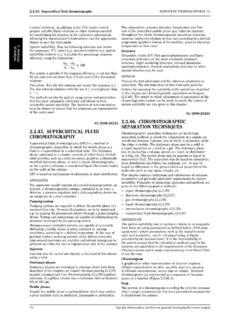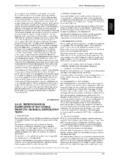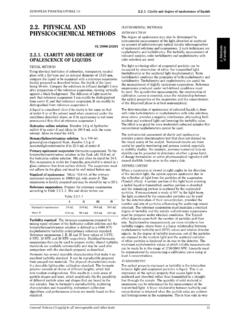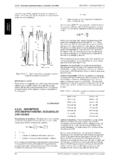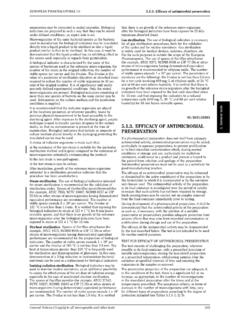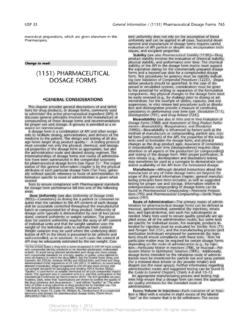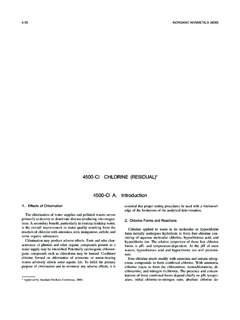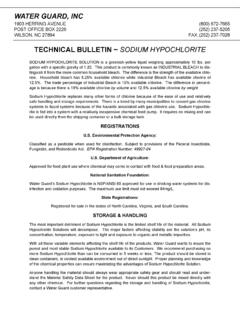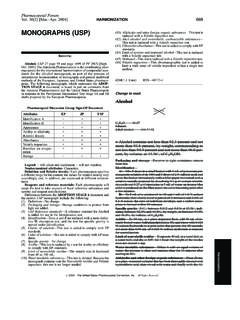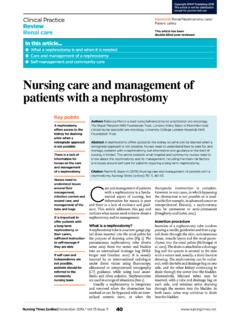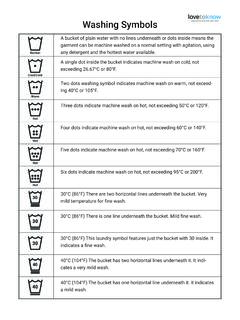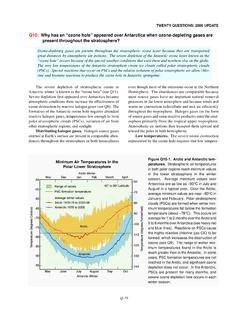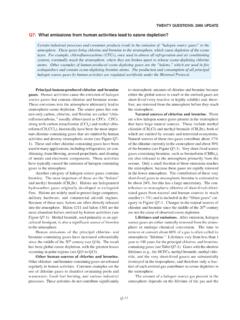Transcription of <88> BIOLOGICAL REACTIVITY TESTS, IN VIVO - DrugFuture
1 94 87 BIOLOGICAL REACTIVITY Tests, In Vitro / BIOLOGICAL TestsUSP 35(mildly reactive). Repeat the procedure if the suitability oflogical REACTIVITY Tests, In Vitro 87 have indicated significantthe system is not confirmed. For dose-response evaluations, BIOLOGICAL REACTIVITY . These two tests are used for plasticsrepeat the procedure, using quantitative dilutions of theand other polymers in addition to a third test, the Implanta-sample Test, to test the suitability of these materials intendedfor use in fabricating containers and accessories thereto, foruse in parenteral preparations, and for use in medical de-Table 2.
2 REACTIVITY Grades for Elution Testvices, implants, and other of all CulturesThese three tests are applied to materials or medical de-0 NoneDiscrete intracytoplasmic granules;vices, if there is a need for classification of plastics and otherno cell lysispolymers based on in vivo BIOLOGICAL REACTIVITY the purpose of this chapter, these definitions apply:1 SlightNot more than 20% of the cells arethe Sample is the specimen under test or an extract pre-round, loosely attached, and with-pared from such a specimen. A Blank consists of the sameout intracytoplasmic granules; occa-quantity of the same extracting medium that is used for thesional lysed cells are presentextraction of the specimen under test, treated in the same2 MildNot more than 50% of the cells aremanner as the extracting medium containing the specimenround and devoid of intracytoplas-under test.
3 A Negative Control1 is a specimen that gives nomic granules; no extensive cell lysisreaction under the conditions of the empty areas between cells3 ModerateNot more than 70% of the cell layerscontain rounded cells or are lysedChange to read:4 SevereNearly complete destruction of thecell layersCLASSIFICATION OF PLASTICSSix Plastic Classes are defined (see Table 1). This classifica-tion is based on responses to a series of in vivo tests forwhich extracts, materials, and routes of administration arespecified. These tests are directly related to the intendedend-use of the plastic articles. The choice of extractants is 88 BIOLOGICAL REACTIVITY representative of the vehicles in preparations with which theplastics are likely to be in contact.
4 The Table 1 classificationTESTS, IN VIVO facilitates communication among suppliers, users, and man-ufacturers of plastics by summarizing the tests to be per-formed for containers for injections and medical devices if aThe following tests are designed to determine the biologi-need for classification response of animals to elastomerics, plastics, and otherWith the exception of the Implantation Test, the proce-polymeric material with direct or indirect patient contact, ordures are based on the use of extracts that, depending onby the injection of specific extracts prepared from the mate-the heat resistance of the material, are prepared at one ofrial under test.
5 It is essential to make available the specificthree standard temperatures: 50 , 70 , and 121 . Therefore,surface area for extraction. When the surface area of thethe class designation of a plastic must be accompanied byspecimen cannot be determined, use g of elastomer oran indication of the temperature of extraction ( , IV-121 , g of plastic or other material for every mL of extractionwhich represents a class IV plastic extracted at 121 , or I-fluid. Also, it is essential to exercise care in the preparation50 , which represents a class I plastic extracted at 50 ).of the materials to be injected or instilled to prevent con-Plastics may be classified as USP Plastic Classes I VI onlytamination with microorganisms and other foreign the basis of the response criteria prescribed in Table tests are described.
6 The Systemic Injection Test and the1 USP High-Density Polyethylene Test are used for elastomeric materials, espe-cially to elastomeric closures for which the appropriate Bio-Table 1. Classification of PlasticsPlastic ClassesaTests to be ConductedIIIIIIIVVVITest MaterialAnimalDoseProcedurebxxxxxxMouse5 0 mL/kgA (iv) mL/animal at eachExtract of Sample in Sodium chlo -xxxxxxRabbitof 10 sitesBride InjectionxxxxxMouse50 mL/kgA (iv)Extract of Sample in 1 in 20 mL/animal at eachtion of Alcohol in Sodium ChloridexxxxxRabbitof 10 sitesBInjectionxxxMouse10 g/kgA (ip) mL/animal at eachExtract of Sample in PolyethylenexxRabbitof 10 sitesBGlycol 400xxxxMouse50 mL/kgA (ip)
7 ML/animal at eachxxxRabbitof 10 sitesBExtract of Sample in Vegetable OilxxImplant strips of SampleRabbit4 strips/animalCsxxImplant SampleRat2 Samples/animalCsUSP35aTests required for each class are indicated by x in appropriate : A (ip) Systemic Injection Test (intraperitoneal); A (iv) Systemic Injection Test (intravenous); B Intracutaneous Test (intracutaneous);C Implantation Test (intramuscular sor subcutaneoussUSP35 implantation).Official from May 1, 2012 Copyright (c) 2011 The United States Pharmacopeial Convention. All rights from by nEwp0rt1 on Thu Dec 01 22:02:54 EST 2011 USP 35 BIOLOGICAL Tests / 88 BIOLOGICAL REACTIVITY Tests, In Vivo95 This classification does not apply to plastics that are in-Table 2.
8 Evaluation of Skin Reactions (Continued)tended for use as containers for oral or topical products, orModerate to severe erythema3that may be used as an integral part of a drug erythema (beet-redness) to slight escharTable 1 does not apply to natural elastomers, which are toformation (injuries in depth)4be tested in Sodium Chloride Injection and vegetable oilsEdema Systemic Injection Test and the Intracutaneous Test areNo edema0designed to determine the systemic and local, respectively,Very slight edema (barely perceptible)1biological responses of animals to plastics and otherSlight edema (edges of area well defined by definitepolymers by the single-dose injection of specific extractsraising)2prepared from a Sample.
9 The Implantation Test is designedModerate edema (raised approximately 1 mm)3to evaluate the reaction of living tissue to the plastic andSevere edema (raised more than 1 mm andother polymers by the implantation of the Sample itself intoextending beyond the area of exposure)4animal tissue. The proper preparation and placement of theaExcludes noninflammatory (mechanical) edema from the blank orspecimens under aseptic conditions are important in theextraction of the Implantation tests are designed for application to plastics andApparatus The apparatus for the tests includes theother polymers in the condition in which they are used.
10 Material is to be exposed to any cleansing or steriliza-AUTOCLAVE Use an autoclave capable of maintaining ation process prior to its end-use, then the tests are to betemperature of 121 , equipped with a thermometer, aconducted on a Sample prepared from a specimen precon-pressure gauge, a vent cock, a rack adequate to accommo-ditioned by the same the test containers above the water level, and a waterFactors such as material composition, processing andcooling system that will allow for cooling of the test con-cleaning procedures, contacting media, inks, adhesives, ab-tainers to about, but not below, 20 immediately followingsorption, adsorption and permeability of preservatives, andthe heating of storage may also affect the suitability of a ma-terial for a specific use.
